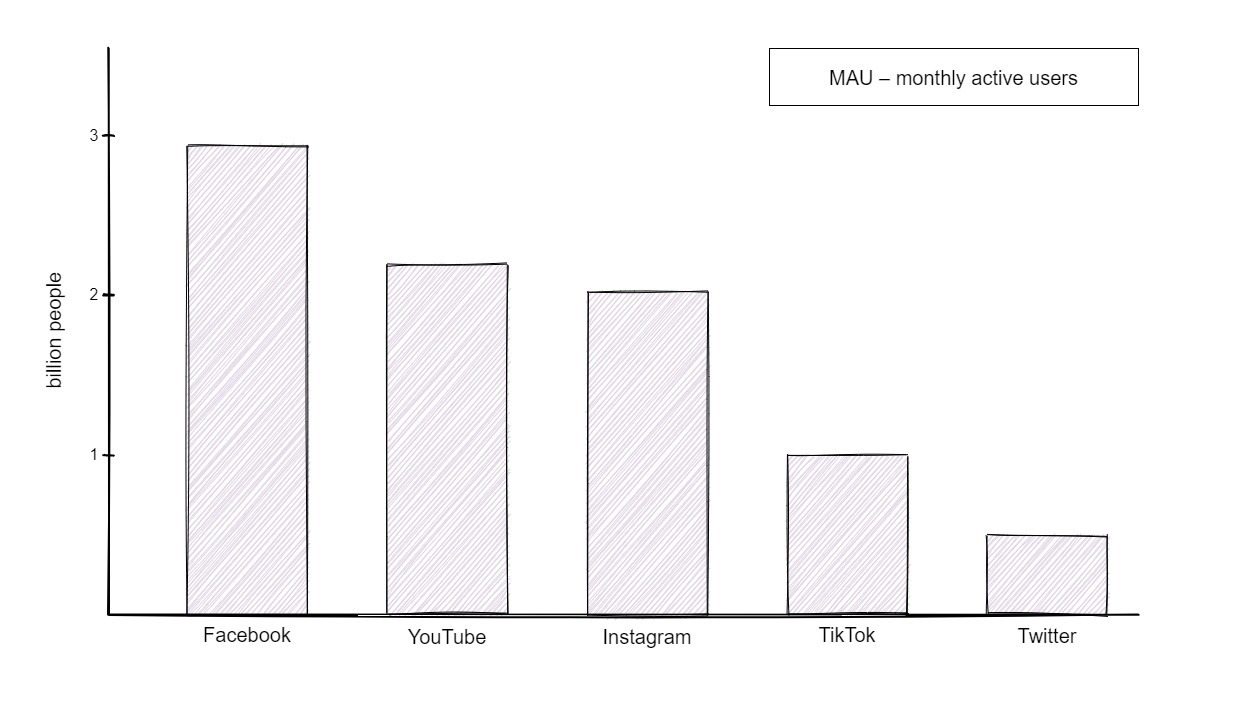
Of all recruiting channels, social media is often underestimated. Platforms like professional LinkedIn or entertainment-based Facebook are crowded with people, and this is an opportunity to attract specialists. Over 90% of talent acquisition managers use SMM recruiting to find new employees. If your company doesn't do it, it’s time to reconsider your approaches and start using social media to your advantage.
These materials will reveal the hiring benefits one can get thanks to social platforms, as well as offer universal tips on what things to mind to succeed. If you want to know more about specific channels, read our article SMM Recruiting: 4 Social Media In Detail. It covers LinkedIn, Xing, Facebook, and Twitter.
These materials will reveal the hiring benefits one can get thanks to social platforms, as well as offer universal tips on what things to mind to succeed. If you want to know more about specific channels, read our article SMM Recruiting: 4 Social Media In Detail. It covers LinkedIn, Xing, Facebook, and Twitter.
Reasons to Use SMM Recruiting

If you start using social media as a hiring tool, you’ll enjoy lots of benefits. Let’s list the most important ones that will convince even the most skeptical employer:
Networks have lots of people
And their number is getting bigger.
According to the latest data, almost 4 billion people use social media in 2022. It’s about half of the global population and almost 5% more than a year ago.
The number of people searching for work there is also impressive. Glassdoor states that almost 80% of job seekers choose social networks to find a new position.
You can attract passive candidates
And find high-quality specialists.
A developer of HR software HR Cloud states that there are over 73% of passive job seekers. IT professionals fall into a special category. Most of them don’t do anything to find a new position. And yet they get lots of offers: recruiters come to them themselves. It’s not that easy to interest such candidates.
Networks have lots of people
And their number is getting bigger.
According to the latest data, almost 4 billion people use social media in 2022. It’s about half of the global population and almost 5% more than a year ago.
The number of people searching for work there is also impressive. Glassdoor states that almost 80% of job seekers choose social networks to find a new position.
You can attract passive candidates
And find high-quality specialists.
A developer of HR software HR Cloud states that there are over 73% of passive job seekers. IT professionals fall into a special category. Most of them don’t do anything to find a new position. And yet they get lots of offers: recruiters come to them themselves. It’s not that easy to interest such candidates.
"IT specialists get lots of direct messages with offers: they’re often very picky. So, we need to think about how to draw their attention. There should be an individual approach with each candidate. As a recruiter, I scan their accounts and try to emphasize those aspects about the vacancy that will appeal to them the most. For example, relocation to a different country, a promising stack, a cool startup with big investments, etc."
Head of Recruitment
Alex Staff Agency
Diana Bolat
Most people you’ll find through social media will be passive. Check their knowledge and experience to make sure they fit the requirements before starting a conversation. Then do your best to get them engaged in a discussion: talk them into giving it a try.
You can adjust the searching
And contact specialists with the required stack and skills.
All social platforms have filters to sift people and find those who fit your position’s requirements. You can narrow down your pool by a programming language, location, keywords, etc. If you take a professional platform like LinkedIn, you can check if candidates have the required hard skills. They’re conveniently added in a special section and can be confirmed by a person’s colleagues and employers. They leave recommendations, working experience, and feedback, which is particularly interesting for recruiters and managers.
Additionally, networks are very informative for the soft skills evaluation. A glimpse at what specialists post, comment and like can reveal a lot about their interpersonal competencies, compatibility with your team’s values, spirit, and mindset. It’s a way to learn more about candidates even before contacting them.
You can decrease recruiting costs
And save time/money.
Finding candidates through networks is usually much cheaper than using any other strategy. For example, let’s take job boards and the way they charge employers who post vacancies. One of the most popular ones is Glassdoor. It doesn’t allow you to post an ad directly: it’s done through Indeed, and then the position appears on Glassdoor.
Let’s evaluate approximate expenses for this job board. For example, you need a developer in Germany. A recommended sum to spend per day is $10, which is about $300 per month. If you want to cover several countries, your budget costs increase proportionately.
We don’t say that social networks are completely free. Some instruments are only available to those willing to pay. For example, by using ads to promote your post. However, such channels open lots of opportunities that are cost-efficient and in some cases free.
You can adjust the searching
And contact specialists with the required stack and skills.
All social platforms have filters to sift people and find those who fit your position’s requirements. You can narrow down your pool by a programming language, location, keywords, etc. If you take a professional platform like LinkedIn, you can check if candidates have the required hard skills. They’re conveniently added in a special section and can be confirmed by a person’s colleagues and employers. They leave recommendations, working experience, and feedback, which is particularly interesting for recruiters and managers.
Additionally, networks are very informative for the soft skills evaluation. A glimpse at what specialists post, comment and like can reveal a lot about their interpersonal competencies, compatibility with your team’s values, spirit, and mindset. It’s a way to learn more about candidates even before contacting them.
You can decrease recruiting costs
And save time/money.
Finding candidates through networks is usually much cheaper than using any other strategy. For example, let’s take job boards and the way they charge employers who post vacancies. One of the most popular ones is Glassdoor. It doesn’t allow you to post an ad directly: it’s done through Indeed, and then the position appears on Glassdoor.
Let’s evaluate approximate expenses for this job board. For example, you need a developer in Germany. A recommended sum to spend per day is $10, which is about $300 per month. If you want to cover several countries, your budget costs increase proportionately.
We don’t say that social networks are completely free. Some instruments are only available to those willing to pay. For example, by using ads to promote your post. However, such channels open lots of opportunities that are cost-efficient and in some cases free.
"We have been using social media as a way of recruiting employees in various fields for a long time now, and I would like to say that many companies underestimate this resource. Our agency’s social networking allows us to attract candidates: we invest in our content and our expertise, and specialists text us themselves, understanding our position and experience in the field."
Lead Marketer
Alex Staff Agency
Polina Malashok
Popular Networks
There are lots of social media platforms nowadays: people do like to connect. Some are professional and meant for job searching. The most popular ones from this category are LinkedIn and Xing, but you might have also heard about such solutions as Bark, Opportunity, and Jobcase. They offer conveniently structured data about talents to facilitate your searching efforts.
Others are designed for communication and entertainment – Facebook, Instagram, etc. They are perfect tools to build your HR branding, as well as control and improve your online presence and reputation. But most importantly, they’re very helpful for recruitment. In 2022, the most popular ones are the following:
Others are designed for communication and entertainment – Facebook, Instagram, etc. They are perfect tools to build your HR branding, as well as control and improve your online presence and reputation. But most importantly, they’re very helpful for recruitment. In 2022, the most popular ones are the following:

We’ve thoroughly analyzed some of these channels in our article SMM Recruiting: 4 Social Media In Detail. Check it out to get tips on what features are hidden in each of them. Knowing how to use them, a business gets more chances of successfully fulfilling its hiring needs.
How to Make SMM Recruiting Effective?
Managing social platforms and making them beneficial only seems simple. They won’t work unless you determine straightforward goals and ways to achieve them. These tips will be a good start if you’re planning to use social networking for recruiting:
1) Choose your platform carefully
The choice heavily depends on what your business is and what specialists you need. Make a portrait of a perfect candidate and determine where most of them hang out. Study each channel's advantages and drawbacks to single out the most promising ones. For example, Facebook has a huge audience, LinkedIn is known for having lots of passive candidates and Xing works better in German-speaking regions.
However, it’s not a wise idea to opt for many platforms simultaneously, especially if you don’t have experience in managing social accounts. Focus on a couple of options that seem to have more potential for you and invest your resources to make them work.
2) Manage your account wisely
Make a plan and post content regularly. It should be relevant information about your team, values, achievements, job offers, etc. Share photos of your office and crew (real pictures, not the ones taken from photo stocks). Hire a designer and improve your outlook: introduce a unified style that will help your followers recognize you even without reading anything.
Encourage audience interaction: choose a responsible employee who will be always there to respond to comments and messages quickly.
3) Study available tools and use them
It won’t be efficient if you miss key built-in features. For example, Twitter is known for hashtags: they help people better navigate through the digital society. The same applies to any channel you choose: each has advanced network features to benefit from. We’ve compiled a guide about LinkedIn, Xing, Facebook, and Twitter there.
4) Build a successful communication pattern
When you send your job ad through email, you’ll write a long letter with all the necessary information. But social media is about dialogue-style communication: you won’t get any results if you apply the same strategy. Instead, group the information into several messages to make it look like a natural conversation.
1) Choose your platform carefully
The choice heavily depends on what your business is and what specialists you need. Make a portrait of a perfect candidate and determine where most of them hang out. Study each channel's advantages and drawbacks to single out the most promising ones. For example, Facebook has a huge audience, LinkedIn is known for having lots of passive candidates and Xing works better in German-speaking regions.
However, it’s not a wise idea to opt for many platforms simultaneously, especially if you don’t have experience in managing social accounts. Focus on a couple of options that seem to have more potential for you and invest your resources to make them work.
2) Manage your account wisely
Make a plan and post content regularly. It should be relevant information about your team, values, achievements, job offers, etc. Share photos of your office and crew (real pictures, not the ones taken from photo stocks). Hire a designer and improve your outlook: introduce a unified style that will help your followers recognize you even without reading anything.
Encourage audience interaction: choose a responsible employee who will be always there to respond to comments and messages quickly.
3) Study available tools and use them
It won’t be efficient if you miss key built-in features. For example, Twitter is known for hashtags: they help people better navigate through the digital society. The same applies to any channel you choose: each has advanced network features to benefit from. We’ve compiled a guide about LinkedIn, Xing, Facebook, and Twitter there.
4) Build a successful communication pattern
When you send your job ad through email, you’ll write a long letter with all the necessary information. But social media is about dialogue-style communication: you won’t get any results if you apply the same strategy. Instead, group the information into several messages to make it look like a natural conversation.
"The most important rule is to avoid making messages too long and keep them as informative as possible. A standard structure consists of 3 parts:
- Introduction. I introduce myself, explain how I’ve found them, refer to mutual acquaintances and ask if they’re open to work changes
- Job description. I tell them about requirements, responsibilities, bonuses, and so on.: the key info
Further instruction. I explain what they should do to participate in the candidate selection process (follow the link, fill out the form, contact me via Telegram, etc.)"
Head of Recruitment
Alex Staff Agency
Diana Bolat
Don’t leave them alone with your messages: check in a bit later (ask a question, offer a call or video meeting, etc.). At the same time, don’t go too far. Otherwise, all you’ll get back is irritation.
Another advantage of communication with specialists through social media is a less official atmosphere. There are stickers and emojis to use to make the conversation more friendly and relaxed.
5) Evaluate your results
Each channel offers opportunities to analyze metrics. They show how your readers react to your posts and whether your efforts are efficient. There are 3 things to mind:
Another advantage of communication with specialists through social media is a less official atmosphere. There are stickers and emojis to use to make the conversation more friendly and relaxed.
5) Evaluate your results
Each channel offers opportunities to analyze metrics. They show how your readers react to your posts and whether your efforts are efficient. There are 3 things to mind:
- Engagement. It involves any interaction of your audience with your content: likes, reposts, and comments. This metric allows you to see which topics attract attention and which are not popular. A/B test your posts and determine the most interesting content to cover.
- Traffic. This indicator shows how many people visit your social page, the number of followers, and link clicks from your posts.
- Conversions. The metric is calculated based on the number of people from your social media audience who turned into your clients/candidates.
Summing Up
We hope we’ve managed to prove that using SMM for recruiting is beneficial for any company. We’ve provided some tips that will help you make the best of the opportunities they offer. If you want to dive deeper, we recommend that you read our article that covers 4 popular social media in more detail. Namely, you’ll learn what features they have for successful recruiting.
If you need assistance with finding specialists to join your team, contact us. We have been in the market long enough to build efficient algorithms for working with social media and searching for talents there.
If you need assistance with finding specialists to join your team, contact us. We have been in the market long enough to build efficient algorithms for working with social media and searching for talents there.

